1998 HONDA CIVIC COUPE child lock
[x] Cancel search: child lockPage 5 of 251
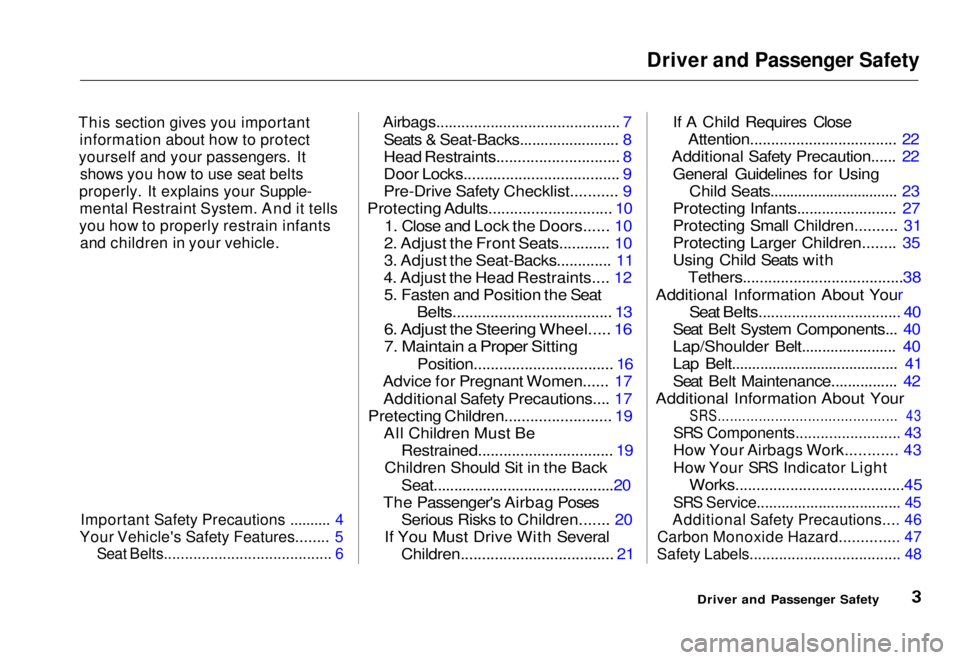
Driver and Passenger Safety
This section gives you important
information about how to protect
yourself and your passengers. It
shows you how to use seat belts
properly. It explains your Supple-
mental Restraint System. And it tells
you how to properly restrain infants
and children in your vehicle.
Important Safety Precautions .......... 4
Your Vehicle's Safety Features........ 5
Seat Belts........................................ 6
Airbags............................................ 7
Seats & Seat-Backs........................ 8
Head Restraints............................. 8
Door Locks..................................... 9
Pre-Drive Safety Checklist........... 9
Protecting Adults............................. 10
1. Close and Lock the Doors...... 10
2. Adjust the Front Seats............ 10
3. Adjust the Seat-Backs............. 11
4. Adjust the Head Restraints.... 12 5. Fasten and Position the Seat
Belts...................................... 13
6. Adjust the Steering Wheel..... 16
7. Maintain a Proper Sitting
Position................................. 16
Advice for Pregnant Women...... 17
Additional Safety Precautions.... 17
Pretecting Children......................... 19 All Children Must Be Restrained................................ 19
Children Should Sit in the Back
Seat............................................20
The Passenger's Airbag Poses Serious Risks to Children....... 20
If You Must Drive With Several Children.................................... 21 If A Child Requires Close
Attention................................... 22
Additional Safety Precaution...... 22
General Guidelines for Using Child Seats................................ 23
Protecting Infants........................ 27
Protecting Small Children.......... 31
Protecting Larger Children........ 35
Using Child Seats with
Tethers......................................38
Additional Information About Your
Seat Belts.................................. 40
Seat Belt System Components... 40
Lap/Shoulder Belt....................... 40
Lap Belt......................................... 41
Seat Belt Maintenance................ 42
Additional Information About Your
SRS............................................ 43
SRS Components......................... 43
How Your Airbags Work............ 43
How Your SRS Indicator Light
Works........................................45
SRS Service................................... 45
Additional Safety Precautions.... 46
Carbon Monoxide Hazard.............. 47
Safety Labels.................................... 48
Driver and Passenger SafetyMain Menu s t
Page 11 of 251
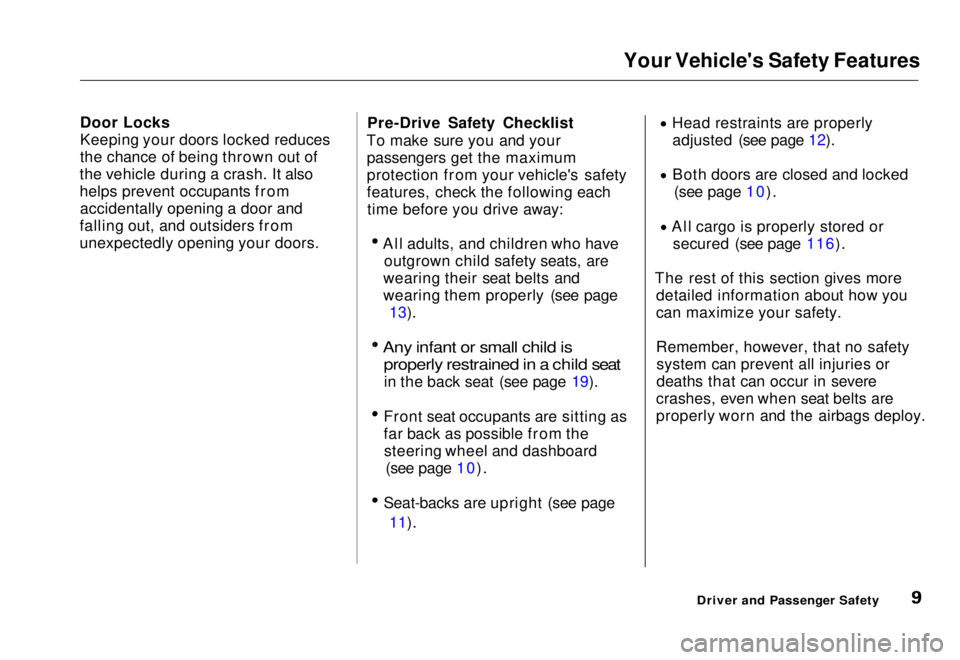
Your Vehicle's Safety Features
Door Locks
Keeping your doors locked reduces
the chance of being thrown out of
the vehicle during a crash. It also
helps prevent occupants from accidentally opening a door and
falling out, and outsiders from
unexpectedly opening your doors. Pre-Drive Safety Checklist
To make sure you and your passengers get the maximum
protection from your vehicle's safety
features, check the following eachtime before you drive away:
All adults, and children who haveoutgrown child safety seats, are
wearing their seat belts and
wearing them properly (see page 13).
Any infant or small child is properly restrained in a child seat
in the back seat (see page 19).
Front seat occupants are sitting as
far back as possible from the steering wheel and dashboard (see page 10). Seat-backs are upright (see page
11). Head restraints are properly
adjusted (see page 12).
Both doors are closed and locked (see page 10). All cargo is properly stored or
secured (see page 116).
The rest of this section gives more detailed information about how you
can maximize your safety.
Remember, however, that no safetysystem can prevent all injuries or
deaths that can occur in severe
crashes, even when seat belts are
properly worn and the airbags deploy.
Driver and Passenger SafetyMain Menu Table of Contents s t
Page 12 of 251
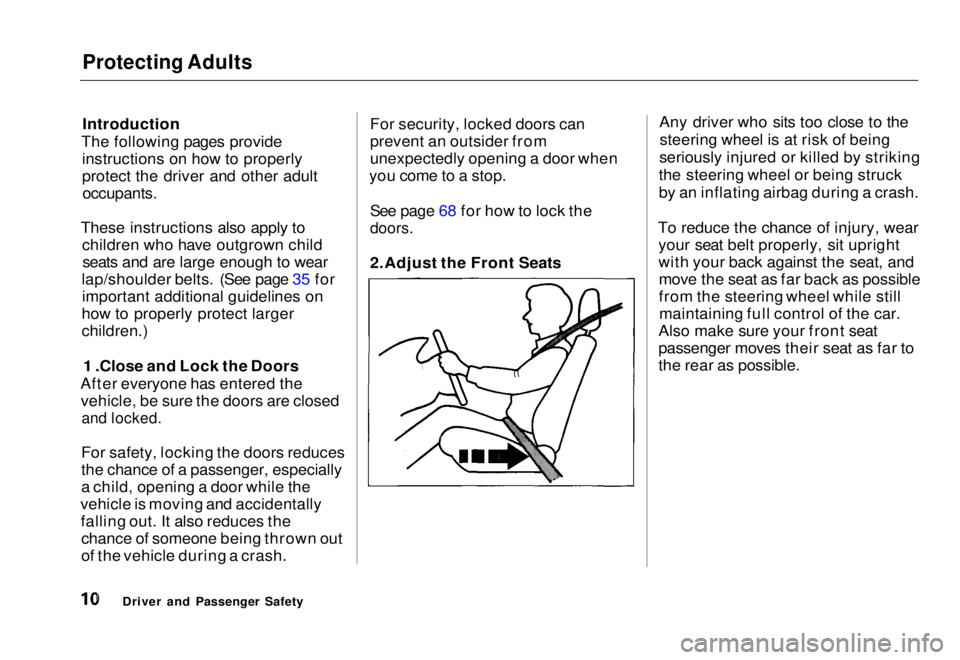
Protecting Adults
Introduction
The following pages provide instructions on how to properly
protect the driver and other adult
occupants.
These instructions also apply to children who have outgrown childseats and are large enough to wear
lap/shoulder belts. (See page 35 for important additional guidelines on
how to properly protect larger
children.)
1 .Close and Lock the Doors
After everyone has entered the vehicle, be sure the doors are closed
and locked.
For safety, locking the doors reduces
the chance of a passenger, especially
a child, opening a door while the
vehicle is moving and accidentally falling out. It also reduces thechance of someone being thrown out
of the vehicle during a crash. For security, locked doors can
prevent an outsider from
unexpectedly opening a door when
you come to a stop.
See page 68 for how to lock the
doors.
2.Adjust the Front Seats Any driver who sits too close to the
steering wheel is at risk of being
seriously injured or killed by striking
the steering wheel or being struck
by an inflating airbag during a crash.
To reduce the chance of injury, wear your seat belt properly, sit upright
with your back against the seat, andmove the seat as far back as possible
from the steering wheel while stillmaintaining full control of the car.
Also make sure your front seat
passenger moves their seat as far to
the rear as possible.
Driver and Passenger SafetyMain Menu Table of Contents s t
Page 30 of 251
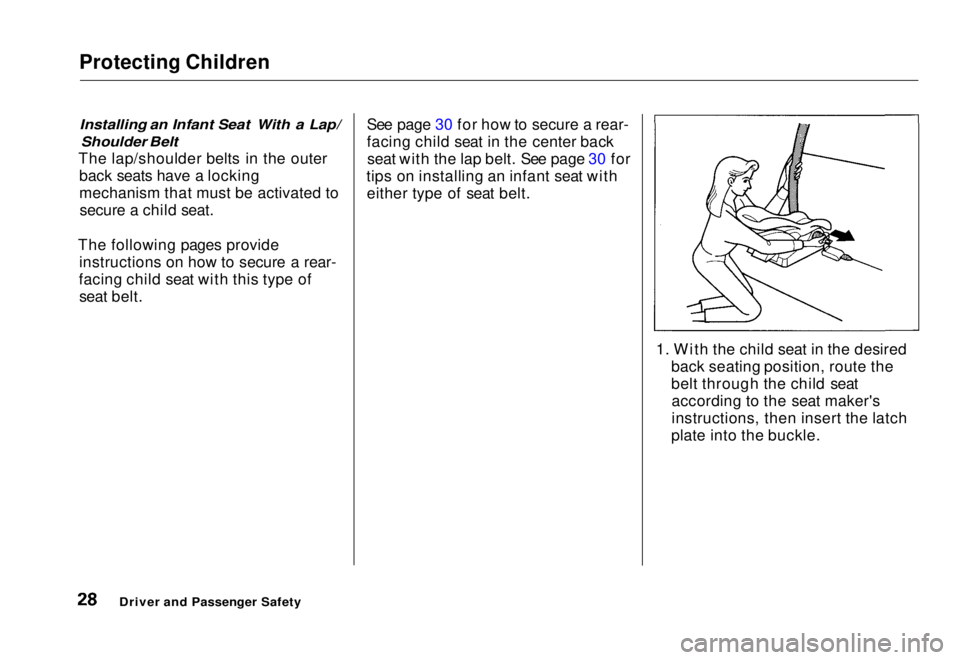
Protecting Children
Installing an Infant Seat With a Lap/
Shoulder Belt
The lap/shoulder belts in the outer back seats have a locking
mechanism that must be activated tosecure a child seat.
The following pages provide instructions on how to secure a rear-
facing child seat with this type of seat belt. See page 30 for how to secure a rear-
facing child seat in the center back
seat with the lap belt. See page 30 for
tips on installing an infant seat with either type of seat belt.
1. With the child seat in the desiredback seating position, route the
belt through the child seataccording to the seat maker's
instructions, then insert the latch
plate into the buckle.
Driver and Passenger SafetyMain Menu Table of Contents s t
Page 31 of 251
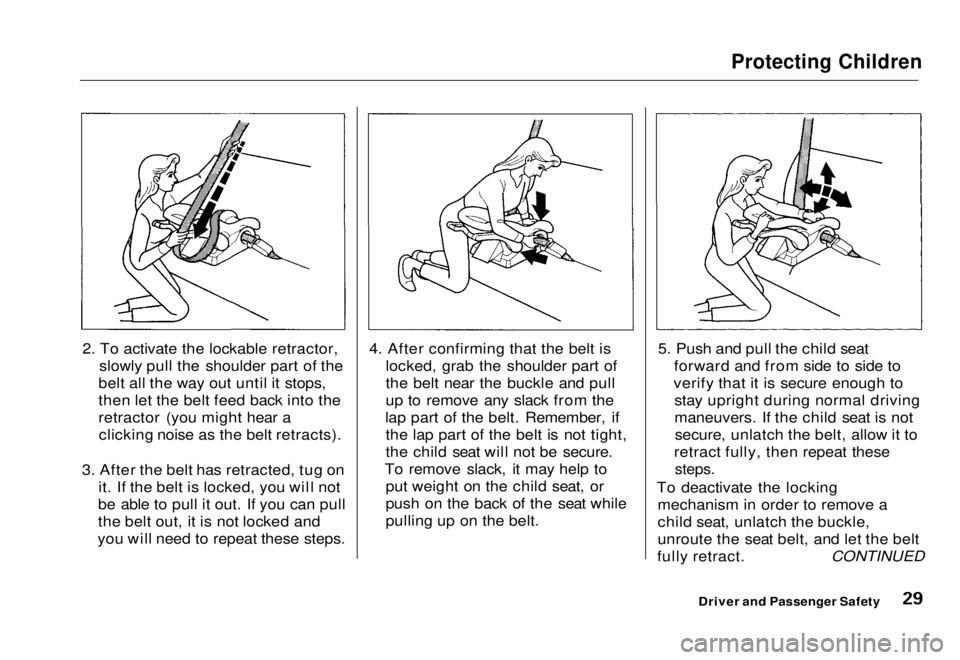
Protecting Children
2. To activate the lockable retractor, slowly pull the shoulder part of the
belt all the way out until it stops,
then let the belt feed back into the
retractor (you might hear a clicking noise as the belt retracts).
3. After the belt has retracted, tug on it. If the belt is locked, you will not
be able to pull it out. If you can pull
the belt out, it is not locked and
you will need to repeat these steps. 4. After confirming that the belt is
locked, grab the shoulder part of
the belt near the buckle and pull
up to remove any slack from the
lap part of the belt. Remember, if the lap part of the belt is not tight,
the child seat will not be secure.
To remove slack, it may help to put weight on the child seat, or
push on the back of the seat while
pulling up on the belt. 5. Push and pull the child seat
forward and from side to side to
verify that it is secure enough to stay upright during normal driving
maneuvers. If the child seat is notsecure, unlatch the belt, allow it to
retract fully, then repeat these
steps.
To deactivate the locking mechanism in order to remove a
child seat, unlatch the buckle,
unroute the seat belt, and let the belt
fully retract. CONTINUED
Driver and Passenger SafetyMain Menu Table of Contents s t
Page 32 of 251
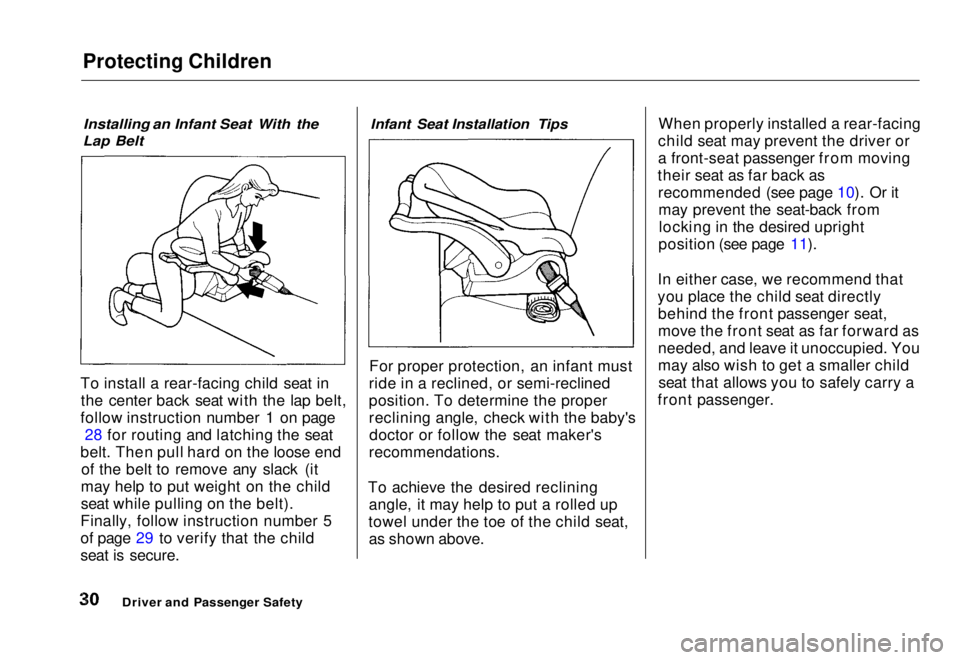
Protecting Children
Installing an Infant Seat With the
Lap Belt
To install a rear-facing child seat in the center back seat with the lap belt,
follow instruction number 1 on page 28 for routing and latching the seat
belt. Then pull hard on the loose end of the belt to remove any slack (it
may help to put weight on the child
seat while pulling on the belt).
Finally, follow instruction number 5
of page 29 to verify that the child
seat is secure.
Infant Seat Installation Tips
For proper protection, an infant must
ride in a reclined, or semi-reclined
position. To determine the proper
reclining angle, check with the baby's doctor or follow the seat maker's
recommendations.
To achieve the desired reclining angle, it may help to put a rolled up
towel under the toe of the child seat, as shown above. When properly installed a rear-facing
child seat may prevent the driver or
a front-seat passenger from moving
their seat as far back as recommended (see page 10). Or itmay prevent the seat-back fromlocking in the desired upright
position (see page 11).
In either case, we recommend that
you place the child seat directly behind the front passenger seat,
move the front seat as far forward as
needed, and leave it unoccupied. You
may also wish to get a smaller childseat that allows you to safely carry a
front passenger.
Driver and Passenger SafetyMain Menu Table of Contents s t
Page 34 of 251
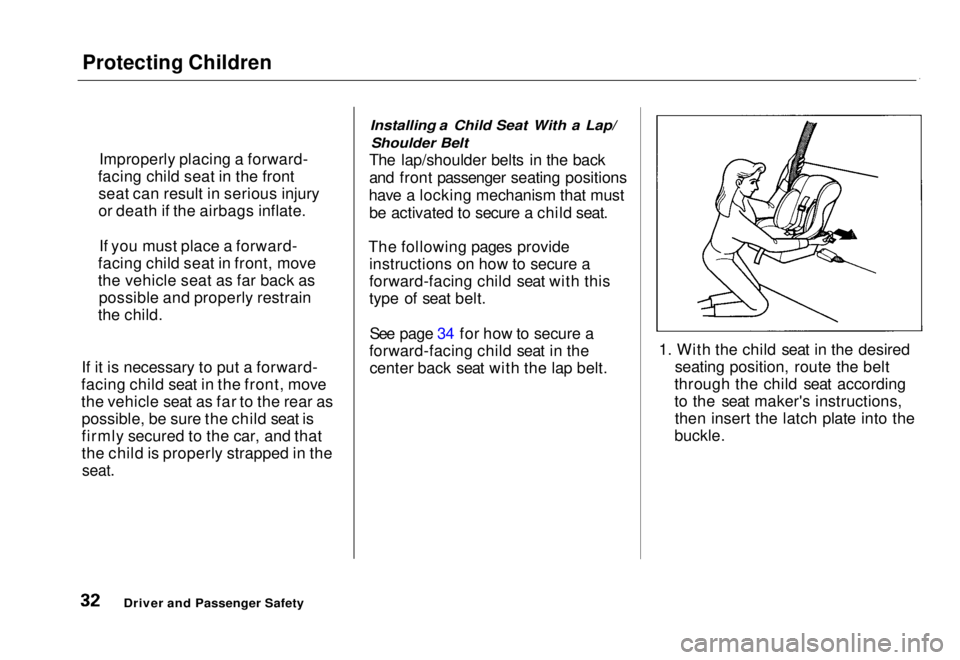
Protecting Children
If it is necessary to put a forward-
facing child seat in the front, move
the vehicle seat as far to the rear as possible, be sure the child seat is
firmly secured to the car, and that
the child is properly strapped in the
seat.
Installing a Child Seat With a Lap/
Shoulder Belt
The lap/shoulder belts in the back
and front passenger seating positions
have a locking mechanism that must be activated to secure a child seat.
The following pages provide instructions on how to secure a
forward-facing child seat with this
type of seat belt.
See page 34 for how to secure a
forward-facing child seat in the center back seat with the lap belt. 1. With the child seat in the desired
seating position, route the belt
through the child seat according
to the seat maker's instructions, then insert the latch plate into the
buckle.
Driver and Passenger Safety
Improperly placing a forward-
facing child seat in the front seat can result in serious injury
or death if the airbags inflate.
If you must place a forward-
facing child seat in front, move
the vehicle seat as far back as possible and properly restrain
the child.Main Menu Table of Contents s t
Page 35 of 251
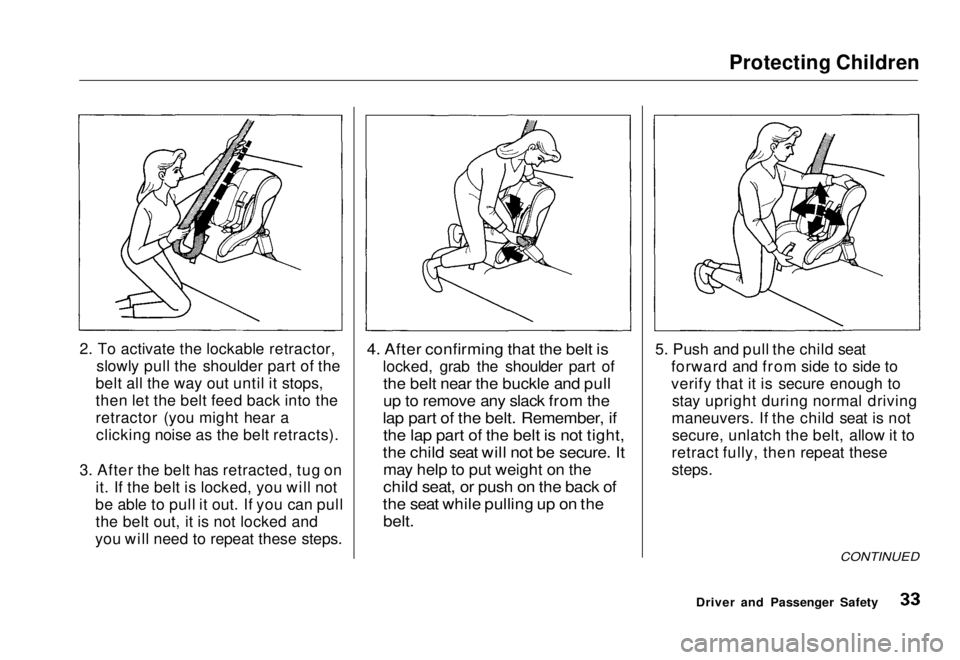
Protecting Children
2. To activate the lockable retractor, slowly pull the shoulder part of the
belt all the way out until it stops,
then let the belt feed back into the
retractor (you might hear a clicking noise as the belt retracts).
3. After the belt has retracted, tug on it. If the belt is locked, you will not
be able to pull it out. If you can pull the belt out, it is not locked and
you will need to repeat these steps.
4. After confirming that the belt is
locked, grab the shoulder part of
the belt near the buckle and pull
up to remove any slack from the
lap part of the belt. Remember, if
the lap part of the belt is not tight,
the child seat will not be secure. It
may help to put weight on the
child seat, or push on the back of
the seat while pulling up on the
belt.
5. Push and pull the child seat
forward and from side to side to
verify that it is secure enough tostay upright during normal driving
maneuvers. If the child seat is not secure, unlatch the belt, allow it to
retract fully, then repeat these
steps.
CONTINUED
Driver and Passenger SafetyMain Menu Table of Contents s t